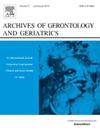Health outcomes and healthcare utilization among older adults based on weight status and muscle strength: Insights from 27 European countries
IF 3.8
3区 医学
Q2 GERIATRICS & GERONTOLOGY
引用次数: 0
Abstract
Background
Overweight/obesity and low muscle strength negatively affect older adults’ health and are public health concerns. While previous studies link these conditions to poor outcomes, few have examined their combined association with healthcare use and chronic diseases. This study aims to assess these relationships.
Methods
A cross-sectional study using data from Wave 8 of the Survey of Health, Ageing and Retirement in Europe. Four groups were formed based on muscle strength(High vs Low)and weight status(Overweight/obesity vs Non-Overweight/obesity): Overweight/obesity and Low Muscle Strength (O/LM), Non- Overweight/obesity and Low Muscle Strength (NO/LM), Overweight/obesity and High Muscle Strength (O/HM), and Non- Overweight/obesity and High Muscle Strength (NO/HM).
Results
Among 53,217 participants(mean age 69.0), 56.9 % were women. Most participants were overweight or obese(63.0 %). Median muscle strength was 41.0 kg for men and 26.0 kg for women. Group distributions included 16.6 % in O/LM, 2.5 % in NO/LM, 53.4 % in O/HM, and 27.5 % in NO/HM. The O/LM group had a higher prevalence of long-term illnesses, multiple chronic diseases, and emergency hospitalizations. They were more likely to take five or more medications. In contrast, the NO/HM group showed better health, with fewer chronic conditions and lower medication use. The O/HM group had more public long-term care insurance. The O/LM group had higher probabilities of chronic diseases such as diabetes, stroke, and Alzheimer's, with risks decreasing across the groups.
Conclusion
Overweight/obesity with low muscle strength significantly increases healthcare utilization and the burden of chronic diseases in older adults, highlighting the need for targeted interventions for this vulnerable group.
基于体重状况和肌肉力量的老年人健康结果和医疗保健利用:来自27个欧洲国家的见解
背景超重/肥胖和肌肉力量不足对老年人的健康产生负面影响,是公共卫生问题。虽然以前的研究将这些情况与不良结果联系起来,但很少有人研究它们与医疗保健使用和慢性病的综合关系。本研究旨在评估这些关系。方法采用欧洲健康、老龄化和退休调查第8轮数据进行横断面研究。根据肌肉力量(高vs低)和体重状况(超重/肥胖vs非超重/肥胖)分为四组:超重/肥胖和低肌肉力量(O/LM),非超重/肥胖和低肌肉力量(NO/LM),超重/肥胖和高肌肉力量(O/HM),非超重/肥胖和高肌肉力量(NO/HM)。结果在53217名参与者(平均年龄69.0岁)中,56.9%为女性。大多数参与者超重或肥胖(63.0%)。男性肌肉力量中位数为41.0 kg,女性为26.0 kg。组间分布为:O/LM组16.6%,NO/LM组2.5%,O/HM组53.4%,NO/HM组27.5%。O/LM组有较高的长期疾病、多种慢性疾病和急诊住院率。他们更有可能服用五种或更多的药物。相比之下,NO/HM组表现出更好的健康状况,更少的慢性疾病和更少的药物使用。O/HM组有更多的公共长期护理保险。O/LM组患糖尿病、中风和阿尔茨海默氏症等慢性疾病的可能性更高,但两组的风险都在降低。结论超重/肥胖伴低肌力显著增加老年人医疗保健利用和慢性病负担,需要针对这一弱势群体进行针对性干预。
本文章由计算机程序翻译,如有差异,请以英文原文为准。
求助全文
约1分钟内获得全文
求助全文
来源期刊
CiteScore
7.30
自引率
5.00%
发文量
198
审稿时长
16 days
期刊介绍:
Archives of Gerontology and Geriatrics provides a medium for the publication of papers from the fields of experimental gerontology and clinical and social geriatrics. The principal aim of the journal is to facilitate the exchange of information between specialists in these three fields of gerontological research. Experimental papers dealing with the basic mechanisms of aging at molecular, cellular, tissue or organ levels will be published.
Clinical papers will be accepted if they provide sufficiently new information or are of fundamental importance for the knowledge of human aging. Purely descriptive clinical papers will be accepted only if the results permit further interpretation. Papers dealing with anti-aging pharmacological preparations in humans are welcome. Papers on the social aspects of geriatrics will be accepted if they are of general interest regarding the epidemiology of aging and the efficiency and working methods of the social organizations for the health care of the elderly.

 求助内容:
求助内容: 应助结果提醒方式:
应助结果提醒方式:


